How to Store Apples in the Refrigerator and Root Cellar
This post may contain affiliate links, which means that I may receive a commission if you make a purchase using these links. As an Amazon Associate I earn from qualifying purchases.
Wondering how to store apples? Discover the best methods for storing apples in a refrigerator and a root cellar to enjoy them all winter.
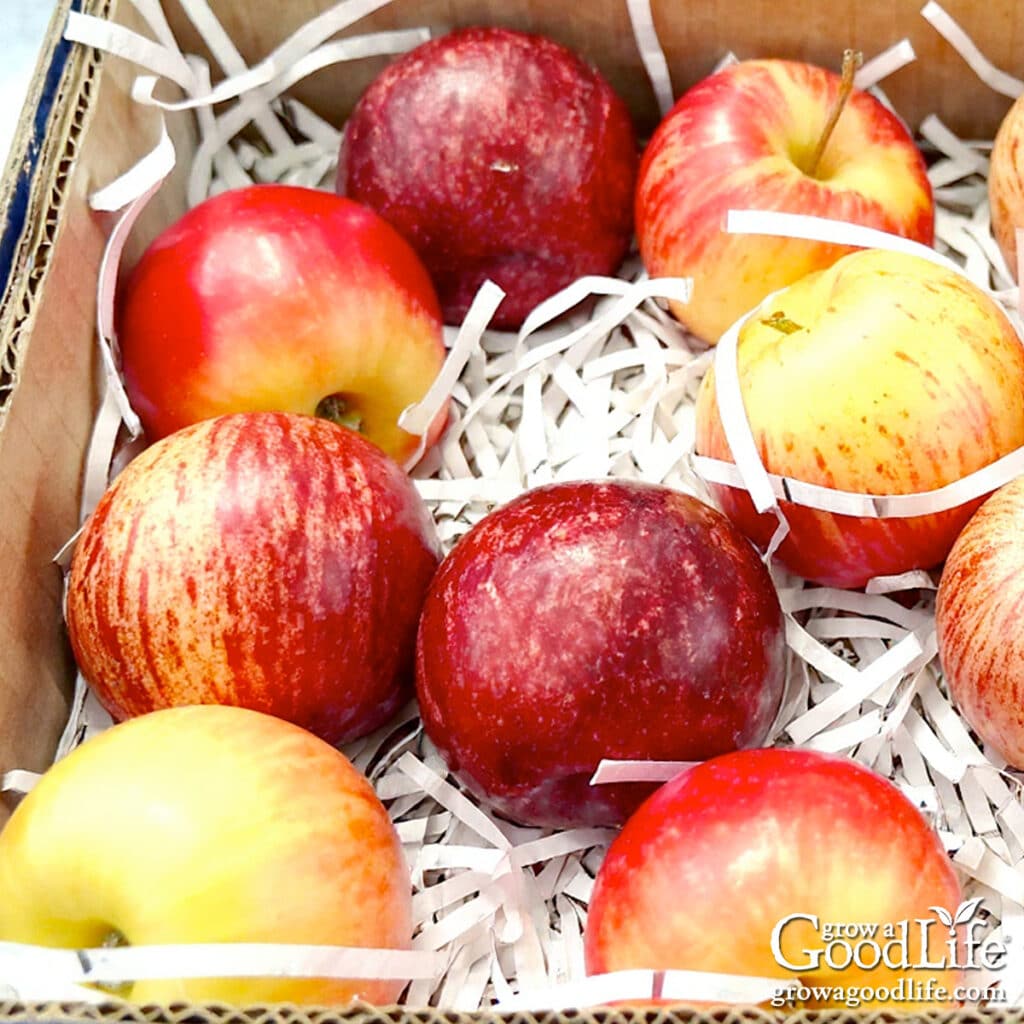
Fresh apples are one of the best treats of fall! Crisp, juicy, and full of flavor. But did you know you can extend that harvest well into winter with the right storage methods? Whether you’re tucking a few apples into the fridge or filling bins in a cool cellar, storing apples correctly can keep them fresh for weeks, and even months.
In this guide, you’ll learn how to select apples for storage, how to keep them in top condition, and the best ways to store them in both the refrigerator and root cellar.
Choosing the Right Apples for Storage
Not every apple is a good keeper. Some varieties are meant for immediate eating, while others are naturally suited for long-term storage. If you are aiming for short-term storage in the refrigerator, most apple varieties will keep for several weeks. However, if you want apples to last for months in a root cellar or cool basement, it’s important to choose the right types.
Short-term Apples
Early-season apples harvested in late August and September, such as Gala and Gravenstein, are best enjoyed fresh. They can still be stored in the refrigerator, but they tend to soften quickly and won’t last as long as late-season varieties.
Best Storage Apples
Late-season apple varieties harvested in October through November have firm flesh and thick skin, making them ideal for storage. Some of the best long-keeping apples include Fuji, Braeburn, Rome, Jonathan, Jonagold, McIntosh, Winesap, Northern Spy, Granny Smith, and Honeycrisp. Under the right conditions, many of these will last well into winter.
Since there are so many regional apple varieties, if you’re buying apples from your local farm stand or orchard, ask the grower which varieties are best for storage.
Harvest and Handling Tips
How you handle your apples makes a big difference in how long they will last in storage. Apples are living fruits, and they continue to respire after picking. Any bruises, blemishes, or excess moisture will accelerate spoilage. By harvesting carefully and giving your apples a little care before storing, you can set them up to stay crisp and delicious for weeks or even months.
- Pick at peak maturity: Apples that are mature but not fully ripe will last longer when stored. Harvest when the skin color has developed fully and apples come off the tree with a gentle twist.
- Avoid bruises: Even small dings or drops shorten shelf life. Handle apples gently and avoid tossing them into buckets or baskets.
- Sort carefully: Only store firm, unblemished apples. Set aside any that are bruised, cracked, or insect-damaged and use them quickly for fresh eating, applesauce, jelly, or dehydrating.
- Keep them dry: Moisture encourages rot and mold growth. Make sure apples are dry before putting them into storage.
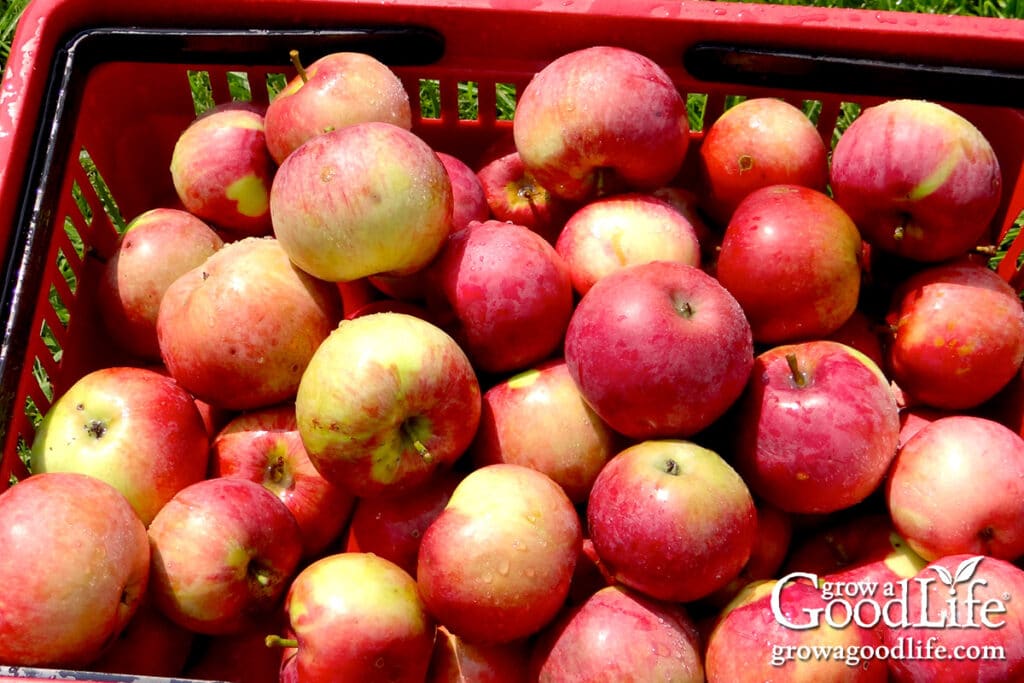
How to Store Apples in the Refrigerator
If you only have a small harvest, the crisper drawer of your refrigerator is the simplest way to keep apples fresh. The cool temperature slows ripening, while the right humidity prevents them from drying out.
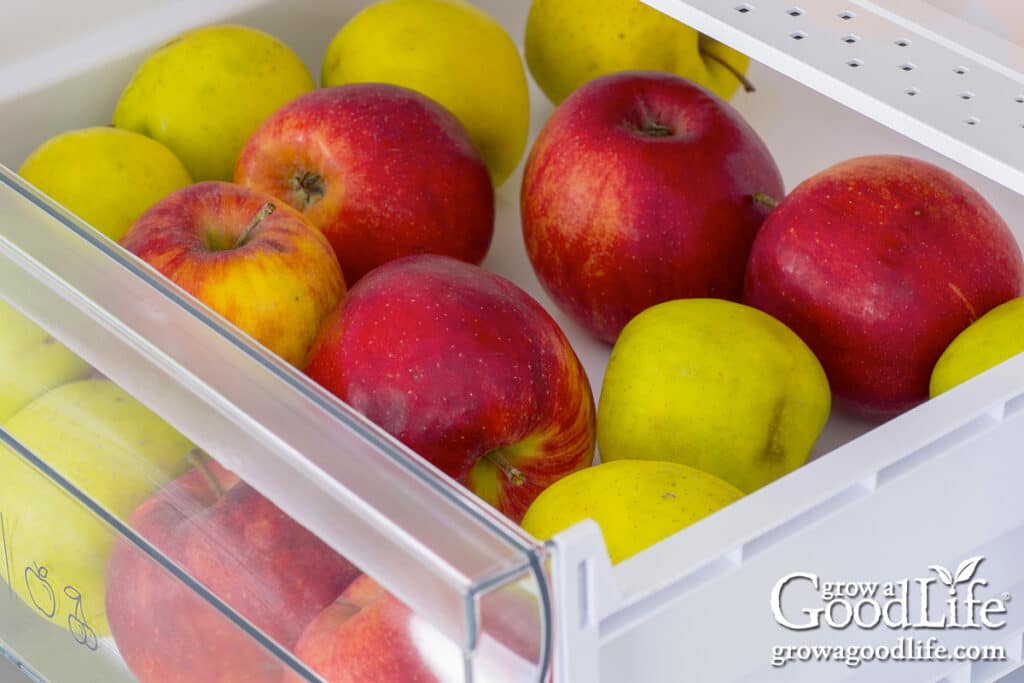
Step 1: Prepare the Crisper Drawer
For best results, dedicate a crisper drawer just for apples. This is the coldest part of the refrigerator, perfect for storing apples. Pull out the drawer and give it a good wash with hot, soapy water. Let it dry while you sort your apples.
Step 2: Sort the Apples
Sort through your apples and choose only firm, unblemished apples for refrigerator storage. Bruised or damaged fruit should be eaten right away or preserved another way. Do not wash apples before storing, as excess moisture can encourage mold growth. Rinse them just before eating instead.
Step 3: Add the Apples to the Crisper Drawer
Layer the drawer with paper towels to help absorb moisture, and slide it into place in the refrigerator. Carefully place the apples in the drawer in a single layer. Add a layer of paper towels, then place another layer of apples on top. Repeat until your drawer is full.
Set the drawer to a low humidity setting for good air circulation, and keep the vent open to allow ethylene gas to escape. Under these conditions, many apple varieties will stay fresh for several weeks, and some late-season keepers can last for a few months.
Step 4: Check the Apples Frequently
You know what they say about one bad apple. Look over your apples at least once a week and remove any that are softening or showing signs of decay, so they don’t affect the others.
Shelf Life in the Fridge
Most apples will last 4 to 6 weeks in the fridge. Late-season varieties, such as Fuji, Northern Spy, or Granny Smith, may stay fresh for up to two months or longer under the right conditions.
How to Store Apples in a Root Cellar
If you have a cool, unheated basement, garage, or a true root cellar, you can store larger quantities of apples and enjoy them for months. The goal is to mimic the natural conditions apples prefer after harvest: cool, dark, and humid.
Skip washing until just before eating to avoid excess moisture that encourages mold. Also, be mindful of what you store nearby. Apples give off ethylene gas, which can cause potatoes to sprout and onions to spoil more quickly, so it’s best to keep them apart.
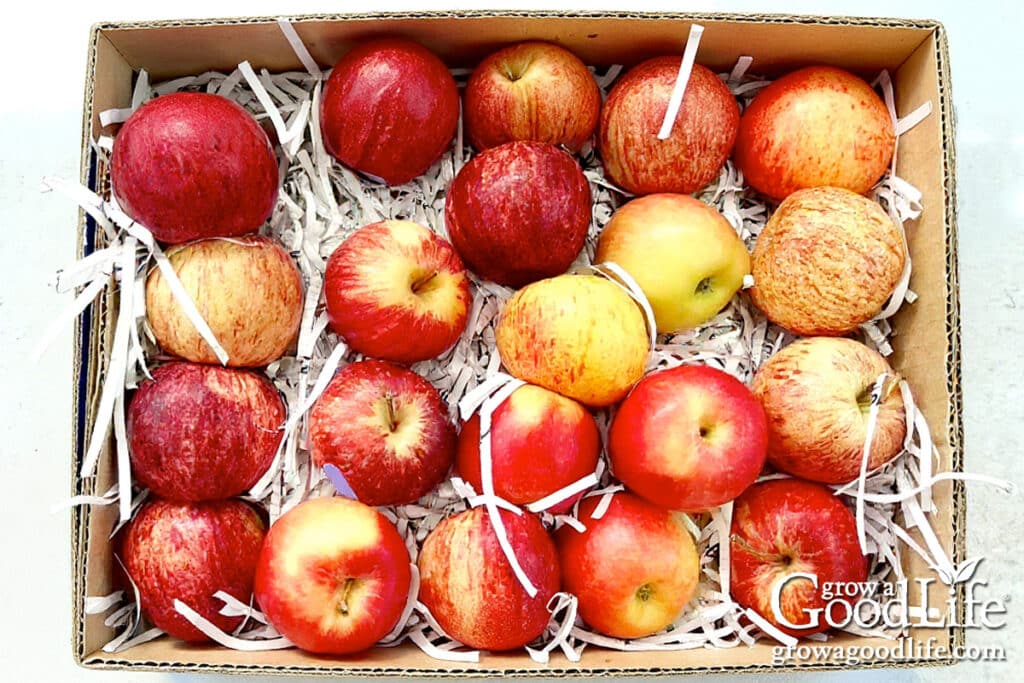
Step 1: Find the Ideal Storage Area
Select a location that remains consistently cool and humid. Apples keep best at 30 to 40°F (just above freezing) with around 90% humidity. Good air circulation helps prevent mold, so avoid airtight spaces.
Step 2: Choose Containers
Wooden crates, slatted shelves, or ventilated boxes are ideal because they allow airflow. Cardboard boxes can also work if lined with newspaper. Avoid sealed plastic tubs, as they trap moisture and encourage mold growth.
Step 3: Wrap and Layer the Apples
For the longest storage, wrap apples individually in newspaper or brown kraft paper before placing them in boxes or crates. This prevents them from touching, reduces bruising, and slows the spread of ethylene gas if one apple ripens faster than the others.
If you don’t wrap, store apples in single layers whenever possible, separating layers with shredded newspaper or cardboard. Avoid stacking fruit too deeply to prevent bruising.
Keep smaller apples separate from larger ones. Smaller fruit tends to ripen and spoil more quickly, so use those first.
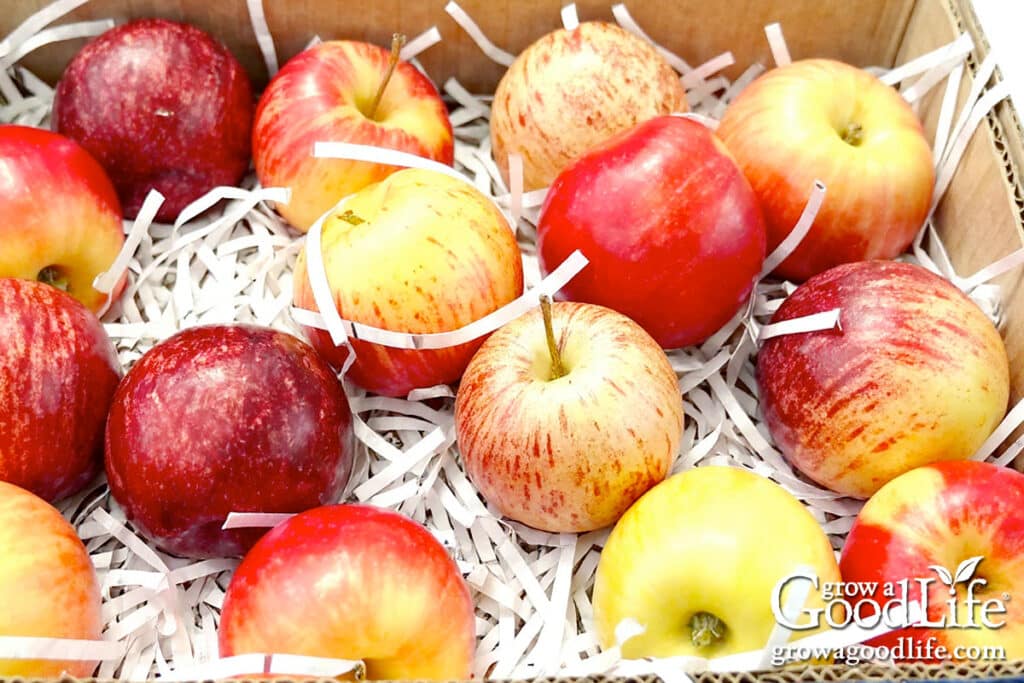
Step 4: Inspect Regularly
Check your stored apples every few weeks. Remove any that are soft, shriveled, or showing signs of rot. Even one spoiled apple can spread quickly through the crate.
Shelf Life in a Root Cellar
Late-season storage varieties, such as Fuji, Jonagold, Northern Spy, and Rome, can last 3 to 6 months in a root cellar if stored under the right conditions.
Apples aren’t the only crop that can be stored this way. From carrots and beets to cabbage and winter squash, many other vegetables thrive in a cool cellar. Learn more in my guide: 14 Crops for Winter Food Storage.
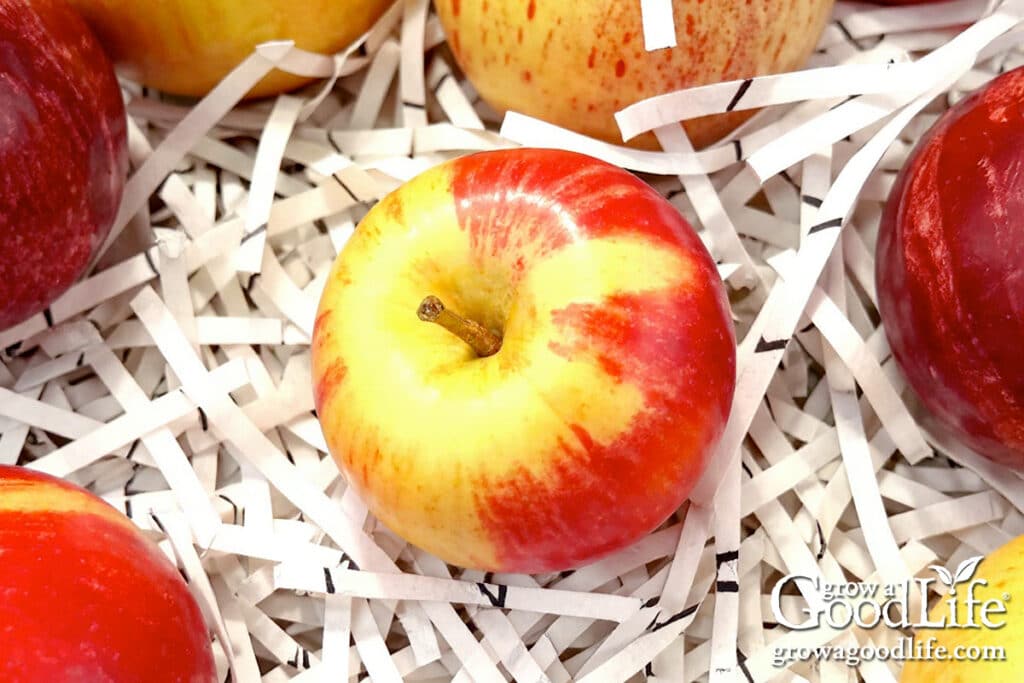
Frequently Asked Questions About Storing Apples
How long do apples last in the fridge? Most apples will keep 4 to 6 weeks in the refrigerator. Late-season storage varieties, such as Fuji or Northern Spy, may last up to 2 months or longer when kept in the crisper drawer.
What apples store the longest? Firm, late-season apples such as Fuji, Braeburn, Jonagold, Northern Spy, and Winesap are excellent keepers. Early-season apples, like Gala or Gravenstein, are best enjoyed fresh.
Can you store apples with potatoes? It’s best to keep apples and potatoes separate from each other. Apples give off ethylene gas, which can cause potatoes to sprout more quickly.
How do you keep apples from spoiling in storage? Select only firm, unblemished apples for apple storage. Handle them gently to prevent bruising, and store them in a cool environment. Check regularly and remove any bruised, soft, or rotten apples so they won’t spoil the whole bunch.
Do apples last longer if they are wrapped in newspaper? Yes. Wrapping apples individually in newspaper or kraft paper helps them last longer in storage. The paper cushions the fruit, prevents apples from touching, and slows the spread of ethylene gas or rot if one apple goes bad.
What can apples be stored with? Apples can be stored with other fruits that tolerate high humidity and cool temperatures, such as pears. However, because both release ethylene gas, it’s best to store them separately if you plan to keep them for more than a few weeks.
What should be stored away from apples? Keep apples away from ethylene-sensitive vegetables like carrots, broccoli, cabbage, and leafy greens. Apples can also cause potatoes and onions to sprout or spoil more quickly, so store them in a different bin or storage area.
Can you store apples outside? If outdoor temperatures stay consistently between 30–40°F, you can store apples in an insulated bin or cooler on a porch, garage, or shed. Just make sure they’re protected from freezing, animals, and large swings in temperature.
Enjoy Crisp Apples All Winter
With the right varieties and storage methods, you can enjoy crisp, flavorful apples well beyond harvest season. Whether you keep a few in the fridge or fill bins in a root cellar, each apple you bite into in mid-winter is a reminder of autumn’s apple picking adventure.
If you’d like to stock up on even more produce to keep in a cool basement, garage, or root cellar, see my guide on 14 Crops for Winter Food Storage.
Looking for more ways to make the most of your apple harvest? Check out my full guide on Ways to Preserve Apples for canning, dehydrating, and more.
